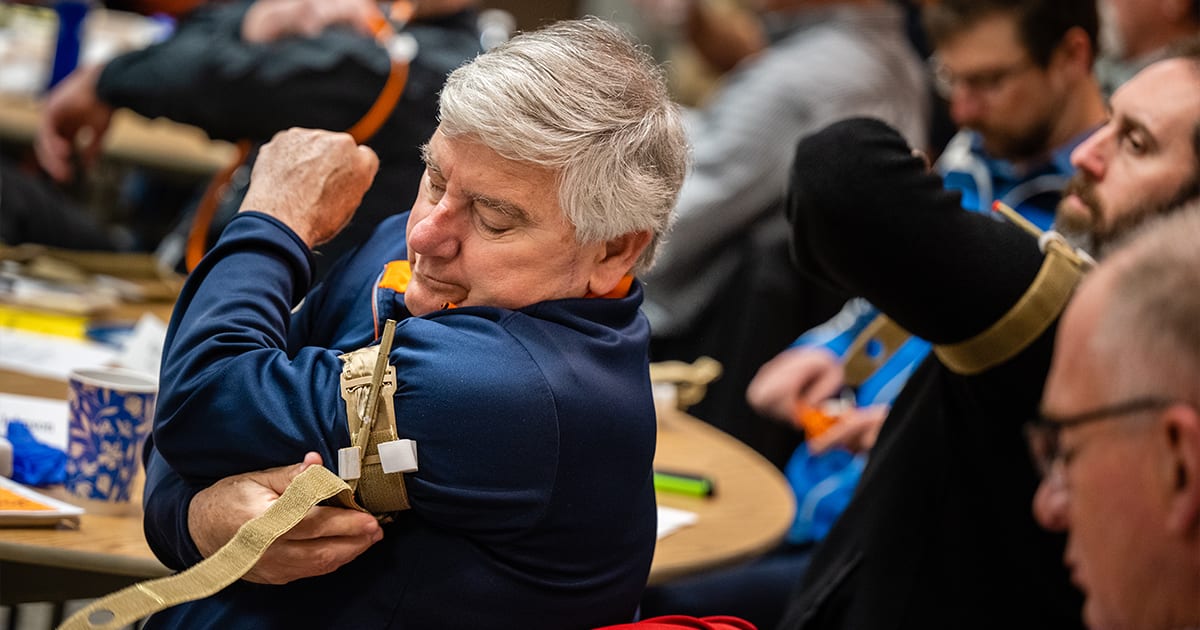
By Cheryl Magness
On April 7 and 8, approximately 30 disaster response leaders from around the Synod gathered at the LCMS International Center in St. Louis to study, discuss and learn “How to Stay Alive in a Crisis.” The conference featured presentations by Ronald J. Bibey, CRNA, and Dr. Matt O’Neill, DPT.
Greeting the participants on the first day of the conference, the Rev. Dr. Ross Johnson, director of LCMS Disaster Response, asked, “What do you do if a catastrophic medical event happens to you or a team member while you are on a disaster site and there is no emergency responder immediately available?” Johnson added that the conditions often associated with disaster situations can make it difficult for responders to reach someone in need in a timely manner.
“Thankfully,” he said, “in 15 years of sending Lutheran Early Response Teams [LERT], we haven’t had a catastrophic incident. But that doesn’t mean it couldn’t happen. This conference is aimed at helping leaders become better prepared so that they can return to their teams and districts and help their volunteers do the same.”
Making the circle grow
As Johnson began the presentation, he used the illustration of a pyramid with the elements, from bottom to top, of Mindset, Tactics, Skill and Gear. The proper mindset, he said, is the foundation to an effective emergency response, with everything else building on it.
Bibey then went through the “5 Bs of emergency intervention”: Bad Guy, Bleeding, Breathing, Brain and Body. The “5 Bs,” he said, outline the five essential elements of any response to a medical emergency:
- Bad Guy — Take stock of the scene and remove (or get away from) any dangerous element that might still be a threat, such as an unstable structure, a harmful item (live wire, noxious gas), or a literal “bad guy” (someone seeking to cause harm);
- Bleeding — Look for and stop bleeding, from most severe to least severe;
- Breathing — Make sure the victim can breathe and, if not, take steps to provide an airway;
- Brain — Maintain breathing and circulation and keep victim calm, warm and awake; and
- Body – Provide a head-to-toe exam, looking for additional injuries and preparing the victim for transport.
Bibey emphasized that while these strategies were designed with disaster volunteers in mind (“What do you do if someone gets injured by a chainsaw or run over by a Bobcat?”), they are also useful in daily life. “You never know when someone is going to need help due to an accident or other kind of life-threatening emergency,” he said.
On the second day of training, participants took part in a “capstone” project in which they divided into teams to respond to three disaster scenarios set up by the presenters. The teams were told to take emergency gear such as bandages and tourniquets with them to each emergency “site” because none would be provided. The scenarios included an accidental laceration from a chainsaw and a fall from the roof of a building resulting in an impalement with a piece of timber.
Bibey described the LCMS group as “one of the best … we have had the honor to instruct. Each of them brought a particular strength to the class. … All were eager to learn new skills and performed well above our expectations during the capstone.
“These team members will make a huge difference in the treatment of injuries sustained by fellow volunteers while being deployed in disaster areas. We look forward to our next training seminar for the LCMS Disaster Response team.”
Toward the end of the training, LCMS President Rev. Dr. Matthew C. Harrison stopped by to greet the participants. “Thank you so much for what you’re doing,” he said. He gave a brief history of LCMS Disaster Response, noting that the Synod’s strength is tapping into and increasing local response. “We take a congregational approach in partnership with many other organizations. All of you are making the circle grow and making a huge difference in the lives of countless people. We are honored to have you here.”
Before departing for home, participants discussed ideas for bringing emergency preparedness training to their own districts and offered comments on the training, including:
- “I was pleasantly surprised by this conference. It was not just another roundtable.”
- “I’ve long had the concern ‘what if?’ This training nailed that.”
- “The trainers were excellent and their presentations clear.”
- “This event changed my entire mindset on how to approach these situations.”
- “These are perishable skills. Training events like these are essential for practicing and reviewing.”
David Ricks, president of Lutheran Disaster Care, a Texas-based LCMS Recognized Service Organization, described the instruction he received as “invaluable.”
“First aid is an important part of disaster response,” Ricks said. “We pray that an accident does not occur, but we deal with some potentially dangerous equipment. There also may be volunteers [from other organizations] who may not practice the same level of safety. If a disaster happens, knowledge [such as that shared in the training] can mitigate the degree of injury or even save a life.”
Ricks added that another benefit of the training was connecting with other disaster response leaders “to share knowledge and experience and brainstorm common problems.” He also appreciated the opportunity “to have input on what LCMS Disaster Response is doing.”
All participants in the training who demonstrated mastery of the content received certification in the American College of Surgeons’ “Stop the Bleed” program. Yet this training was only the beginning. The next step, said Ross, “is for each of the key disaster response leaders to go back to their districts and coordinate advanced first aid training events so that their LERT members will have the basic preparation needed to respond to a medical emergency that might happen to them, a stranger, a family member or a LERT member.”
Find out more about LCMS Disaster Response.
Posted May 26, 2022